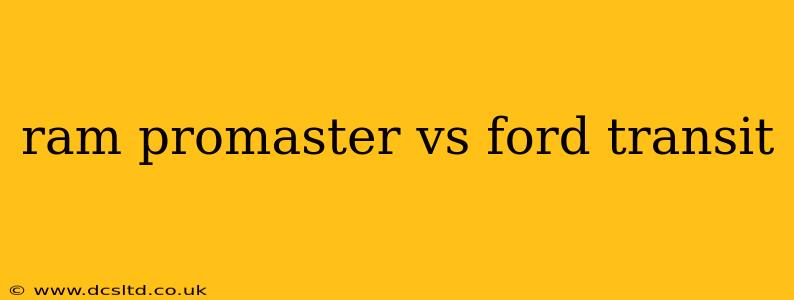The Ram ProMaster and Ford Transit are heavy-duty workhorses, dominating the large van market. But which one reigns supreme? The answer, as with most things, depends on your specific needs. This comprehensive comparison will delve into the key differences to help you make an informed decision.
Key Differences: A Quick Overview
Before we dive into the details, let's highlight the major distinctions between these two vans:
-
Front-Wheel Drive vs. Rear-Wheel Drive: The Ram ProMaster utilizes a front-wheel-drive system, while the Ford Transit offers both rear-wheel and all-wheel-drive options. This fundamental difference significantly impacts handling, payload capacity, and overall driving experience.
-
Payload Capacity: Both vans boast impressive payload capacities, but the exact figures vary depending on the configuration. Generally, the Ford Transit can handle slightly heavier loads, particularly in its heavier-duty configurations.
-
Interior Space and Accessibility: The ProMaster's unique front-wheel-drive design allows for a low floor and expansive cargo area, maximizing cubic feet. The Transit, while spacious, might offer slightly less usable space depending on the configuration.
-
Fuel Efficiency: Fuel economy is a crucial factor for any commercial vehicle. While both vans are relatively fuel-efficient for their size, the Ram ProMaster often edges out the Ford Transit in this category, especially in certain configurations.
-
Price and Maintenance: Pricing varies widely depending on trim level and features. Generally, the initial purchase price and long-term maintenance costs are comparable, although this can vary based on specific options and regional factors.
Ram ProMaster: Advantages and Disadvantages
Advantages:
- Exceptional Cargo Space: The low floor and boxy design maximize cargo capacity, offering unparalleled space for transporting large items.
- Maneuverability: The front-wheel-drive system provides superior maneuverability in tight urban environments.
- Often Better Fuel Economy: Generally, the ProMaster boasts better fuel economy compared to its Ford counterpart.
- Smooth Ride: The front-wheel-drive system contributes to a smoother ride, especially on uneven roads.
Disadvantages:
- Lower Payload Capacity (Generally): While substantial, the ProMaster's payload capacity is typically lower than the Transit's, particularly in higher GVWR configurations.
- Limited Powertrain Options: Compared to the Transit, the ProMaster might have fewer engine and transmission options.
- Less Robust Off-Road Capability: The front-wheel-drive system limits off-road performance.
Ford Transit: Advantages and Disadvantages
Advantages:
- Higher Payload Capacity (Generally): The Transit usually offers a higher payload capacity, making it ideal for heavier loads.
- More Powertrain Options: The Transit provides a broader range of engine and transmission choices to suit various needs.
- Rear-Wheel and All-Wheel Drive Options: This offers improved traction and off-road capability, especially important in challenging conditions.
- Extensive Customization Options: The Transit is highly customizable, allowing you to tailor it to your specific requirements.
Disadvantages:
- Higher Floor Height: The higher floor compared to the ProMaster can make loading and unloading slightly more challenging.
- Potentially Lower Fuel Economy: While fuel efficiency has improved, the Transit may not match the ProMaster in some configurations.
- Less Maneuverable: The rear-wheel-drive system can be less maneuverable in tight spaces.
Which Van is Right for You?
The best choice depends on your priorities.
-
Choose the Ram ProMaster if: You prioritize maximizing cargo space, maneuverability in urban areas, and fuel efficiency.
-
Choose the Ford Transit if: You need a higher payload capacity, prefer rear-wheel or all-wheel drive, and require more powertrain options and customization.
What is the difference in reliability between a Ram ProMaster and a Ford Transit?
Reliability depends on various factors including maintenance, driving conditions, and specific model year. Both brands have experienced issues with certain model years and components. Thorough research into specific model years and reviews from owners is essential before purchasing either van. Independent sources like repair data aggregators can offer valuable insights into common problems.
Which van has a better warranty?
Warranty details vary depending on the model year and specific trim level. It's crucial to check the manufacturer's website for the most up-to-date warranty information for each specific van model.
Which van is easier to repair and maintain?
Accessibility of parts and the complexity of repairs vary. Consulting with mechanics familiar with both vans can provide valuable insights into the potential maintenance costs and ease of repairs for each model.
What are the running costs of each van?
Running costs, encompassing fuel, maintenance, and repairs, are significantly influenced by usage, driving style, and chosen model. Careful analysis of fuel consumption data, potential maintenance issues, and part prices should be considered.
This comparison provides a starting point. Conduct thorough research, test drive both vans, and consider your specific needs before making your final decision. Remember to check reviews from other users to get a more complete picture of real-world experience.
